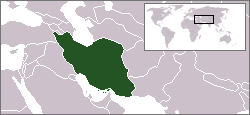Islamic Republic of Iran
From Themarshallwiki
| Jomhuri-ye Islami-ye Iran Islamic Republic of Iran | |
| | |
 | 
|
| Flag | Coat of arms |
| | |
| Motto Esteqlal, azadi, jomhuri-ye eslami "Independence, freedom, Islamic Republic" | |
| Anthem Sorud-e Melli-ye Iran | |
| | |

| |
| | |
| Capital Largest city | Tehran Tehran |
| | |
| Official languages | Persian (Farsi) |
| | |
| Government - Supreme Leader - President - Speaker of the Majlis | Islamic republic Ayatollah Ali Khamenei Mahmoud Ahmadinejad Ali Larijani |
| | |
| Establishment - Median Kingdom - Pahlavi dynasty established - Islamic Republic established | 625BC 1925 1979 |
| | |
| Area - Total - Water (%) | 1,648,195 km2 636,372 sq mi 0.7 |
| | |
| Population - July 2008 est. - Density | 70,472,846 42/km2 109/sq mi |
| | |
| GDP - Total - Per capita | 2008 estimate $382.328 billion $5,246 |
| | |
| Gini | 44.5 (medium) |
| | |
| HDI | 0.777 (medium) |
| | |
| Currency | Iranian rial (IRR)
|
| | |
| Time zone - Summer (DST) | IRST (UTC+3:30) (IRDT) (UTC+4:30) |
| | |
| Internet TLD | .ir |
| | |
| Calling code | +98 |
Iran is a theocratic republic in central Eurasia. Its official name is the Islamic Republic of Iran. The name Iran is a cognate of Aryan, and means "Land of the Aryans". Iran is a founding member of the UN, NAM, OIC and OPEC. The political system of Iran, based on the 1979 Constitution, comprises several intricately connected governing bodies. The highest state authority is the Supreme Leader. Shia Islam is the official religion and Persian is the official language.
Contents |
Provinces and Cities
Iran is divided into thirty provinces (ostan), each governed by an appointed governor (ostandar). The provinces are divided into counties (shahrestan), and subdivided into districts (bakhsh) and sub-districts (dehestan).
Iran's major cities are Tehran, Isfahan, Ahvaz, and Qom.
Politics and Government
The political system of the Islamic Republic is based on the 1979 Constitution. The system comprises several intricately connected governing bodies. The Supreme Leader of Iran is responsible for delineation and supervision of the general policies of the Islamic Republic of Iran. The Supreme Leader is Commander-in-Chief of the armed forces, controls the military intelligence and security operations; and has sole power to declare war or peace.
The heads of the judiciary, state radio and television networks, the commanders of the police and military forces and six of the twelve members of the Council of Guardians are appointed by the Supreme Leader.
The Assembly of Experts elects and dismisses the Supreme Leader on the basis of qualifications and popular esteem.
After the Supreme Leader, the Constitution defines the President of Iran as the highest state authority. The President is elected by universal suffrage for a term of four years and can only be re-elected for one term. Presidential candidates must be approved by the Council of Guardians prior to running in order to ensure their allegiance to the ideals of the Islamic revolution. The President is responsible for the implementation of the Constitution and for the exercise of executive powers, except for matters directly related to the Supreme Leader, who has the final say in all matters. The President appoints and supervises the Council of Ministers, coordinates government decisions, and selects government policies to be placed before the legislature.
As of 2008, the Legislature of Iran (also known as the Majlis of Iran) is a unicameral body. Before the Iranian Revolution, the legislature was bicameral, but the upper house was removed under the new constitution. The Majlis of Iran comprises 290 members elected for four-year terms. The Majlis drafts legislation, ratifies international treaties, and approves the national budget. All Majlis candidates and all legislation from the assembly must be approved by the Council of Guardians.
The Expediency Council has the authority to mediate disputes between Parliament and the Council of Guardians, and serves as an advisory body to the Supreme Leader, making it one of the most powerful governing bodies in the country.
Local City Councils are elected by public vote to four-year terms in all cities and villages of Iran.
Foreign Relations
Iran has difficult relations with most of the world. Iran's foreign relations are based on two strategic principles: eliminating outside influences in the region and pursuing extensive diplomatic contacts with developing and non-aligned countries. Iran maintains diplomatic relations with almost every member of the United Nations, except for Israel, which Iran does not recognize, and the United States since the Iranian Revolution.
Armed Forces
see main article Military of the Islamic Republic of Iran
Iran has two types of armed forces, the regular forces (Islamic Republic of Iran Army, Islamic Republic of Iran Navy, Islamic Republic of Iran Air Force, Islamic Republic of Iran Air Defence Forces), and the Army of the Guardians of the Islamic Revolution (known in the West as the Iranian Revolutionary Guards Corps). Iran's armed forces have about 850,000 regulars, and 350,000 IRGC.
The embargo on foreign arms has forced Iran to develop a military industry producing tanks, small arms, artillery, ballistic missiles.
Economy
Iran's economy is a combination of state central planning, state-ownership of oil and other large enterprises, village agriculture, and small scale, privately owned trading ventures.
